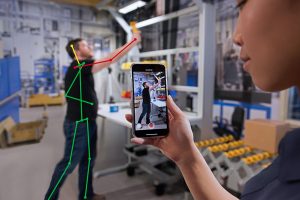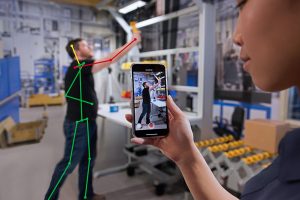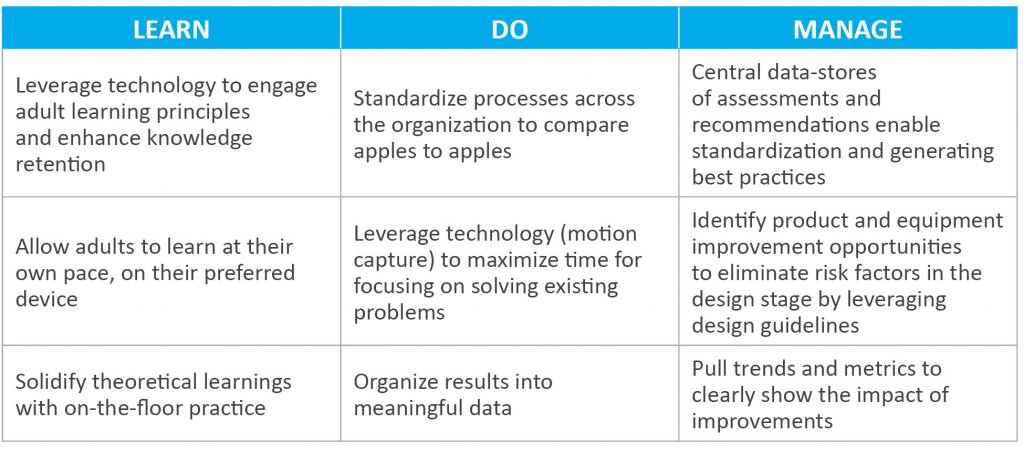Leverage Technology to Drive your Ergonomics Process
11/14/2019

After being an ergonomist for almost 15 years, I can honestly say that I have never been more excited about the future of this field. When I first began working at Humantech and would do wall-to-wall assessments every week, I didn’t think I would last. The pen-and-paper based methods we used were often a little too simple to uncover all of the risks that our professional experience taught us were present. I also had terrible handwriting and would often come back to the office after a data collection and not understand my own notes! 15 years later, cutting edge technologies make things more efficient. I wish I was still going on site to do data collections, because the process is so much better now. Here are three ways that technology has vastly improved the field of ergonomics.
LEARNING
Training has evolved over time, along with access to technology, and we have a better understanding of how adults learn best. While traditional training focused on telling, research is showing, and actions are proving, that we need to shift from instructor-led to self-paced and action-oriented workshops.
The amount of classroom-based, instructor-led training in U.S. companies has recently dropped below 50%, accompanied by a rise in virtual classroom events and online self-study (O'Leonard, 2015). However, research shows that even when video-based training is well designed, on its own it is effective only about 20% of the time (Center for Creative Leadership). Following an online training, hands-on application of learned information or skills enables participants to apply the concepts, information, tools, and methods in real workplace situations. Delivering both skills and awareness training using the blended learning approach yields the best results.
Online training must be based on principles of adult learning and should include the following features:
- Self-paced
- Interactive
- Available in preferred language
- Accessible in small chunks
- Covers difficult topics, but in an easy-to-digest manner
- Includes knowledge checks at regular intervals
We're at a unique point in time when we have free access to millions of trainings at our fingertips, and those short lessons are structured the way they are for a reason: that's how people want to consume it.
DOING
Once you have trained people, how do they actually do the assessments? Advances in technology now allow us to use our cell phones to record a video of a person performing a work task; using the video, software can quickly map all of the worker’s joint angles. Advances in technology have given us tools with

- higher speeds, reducing evaluation time from hours to minutes. This frees up time for more employee engagement and focusing on risk reduction versus risk identification.
- improved accuracy, limiting variation among assessors as well as the dreaded pencil-pushing just to get the assessments done, however inaccurate.
- minimal equipment. No sensors, wearables, or other equipment is required, just a basic camera phone.
Motion capture technology requires far less education and training than previous methods, which opens up the possibility to make ergonomics everyone's job, not just that of a select few. Instead of relying on just a handful of people across a company or site, we can begin to educate everyone and involve them in not just using the solution, but also planning for implementation.
MANAGING
Just like the shift from physical to electronic assessment tools, we have also seen a shift from physical to electronic information retrieval. Data is great, but to leverage it, you must organize it for easy retrieval and interpretation. A central storage location improves accessibility and communication. Storing this data electronically also allows us to see it from both a site-level and corporate-level view. We can use valuable collaboration time from merely sharing issues, to focusing on solving the issues and replicating improvements across the organization. Sharing best practices saves time and increases consistency across organizations.
Cloud-based software gives companies a central access point from which to retrieve trends and metrics. It also makes it easier to eliminate risk factors in the design stage by showing us pending risk factors, and to use design guidelines to address them.
Managing your ergonomics process couldn’t be easier. I wish first-year-consultant me had this technology to make the data collection and report-writing process easier. But it has been nice to have a front-row seat to the future of this field.







